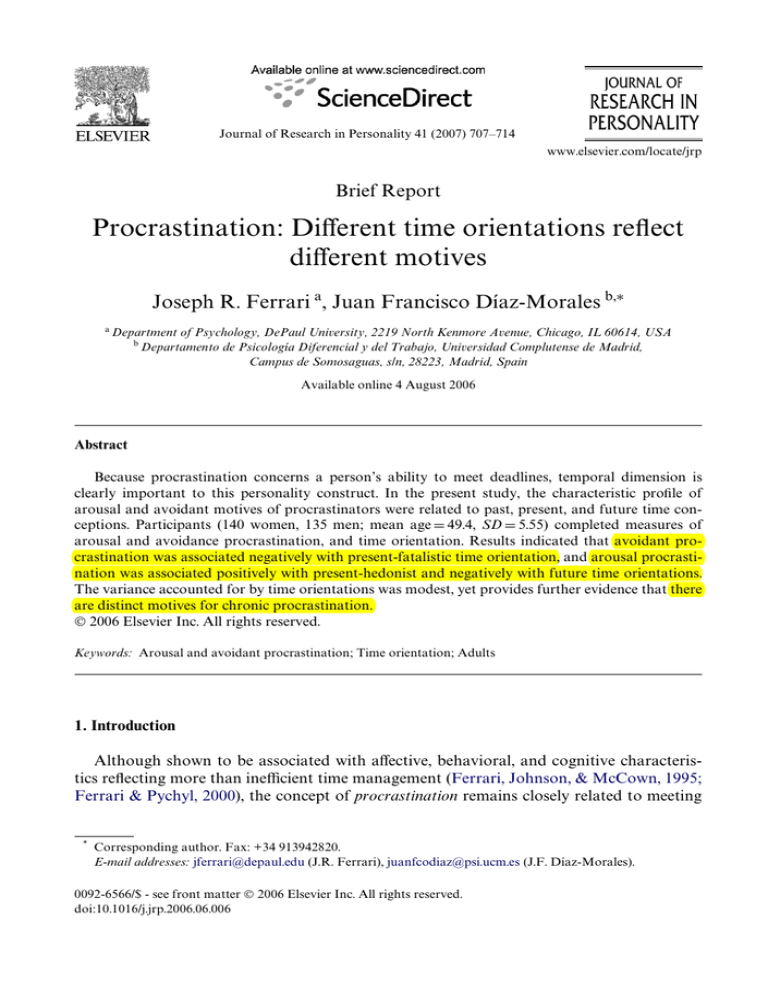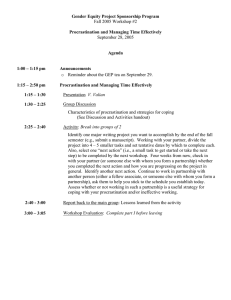
Journal of Research in Personality 41 (2007) 707–714
www.elsevier.com/locate/jrp
Brief Report
Procrastination: DiVerent time orientations reXect
diVerent motives
Joseph R. Ferrari a, Juan Francisco Díaz-Morales b,¤
a
Department of Psychology, DePaul University, 2219 North Kenmore Avenue, Chicago, IL 60614, USA
b
Departamento de Psicología Diferencial y del Trabajo, Universidad Complutense de Madrid,
Campus de Somosaguas, s/n, 28223, Madrid, Spain
Available online 4 August 2006
Abstract
Because procrastination concerns a person’s ability to meet deadlines, temporal dimension is
clearly important to this personality construct. In the present study, the characteristic proWle of
arousal and avoidant motives of procrastinators were related to past, present, and future time conceptions. Participants (140 women, 135 men; mean age D 49.4, SD D 5.55) completed measures of
arousal and avoidance procrastination, and time orientation. Results indicated that avoidant procrastination was associated negatively with present-fatalistic time orientation, and arousal procrastination was associated positively with present-hedonist and negatively with future time orientations.
The variance accounted for by time orientations was modest, yet provides further evidence that there
are distinct motives for chronic procrastination.
© 2006 Elsevier Inc. All rights reserved.
Keywords: Arousal and avoidant procrastination; Time orientation; Adults
1. Introduction
Although shown to be associated with aVective, behavioral, and cognitive characteristics reXecting more than ineYcient time management (Ferrari, Johnson, & McCown, 1995;
Ferrari & Pychyl, 2000), the concept of procrastination remains closely related to meeting
*
Corresponding author. Fax: +34 913942820.
E-mail addresses: jferrari@depaul.edu (J.R. Ferrari), juanfcodiaz@psi.ucm.es (J.F. Díaz-Morales).
0092-6566/$ - see front matter © 2006 Elsevier Inc. All rights reserved.
doi:10.1016/j.jrp.2006.06.006
708
J.R. Ferrari, J.F. Díaz-Morales / Journal of Research in Personality 41 (2007) 707–714
deadlines within a speciWc timeframe. Chronic procrastinators compared to non-procrastinators spend less preparation time on tasks likely to succeeded and more time on projects
likely to fail (Lay, 1990), underestimate the overall time required to complete a task (Burt
& Kemp, 1994), spend less time searching for information needed to complete tasks (Ferrari & Dovidio, 2000), start tasks intended to be completed early at the last minute (Lay &
Burns, 1991; Pychyl, Morin, & Salmon, 2000), and are “present-oriented” (Blatt & Quinlan, 1967; in Ferrari et al., 1995). Procrastinators report diYculties in structuring their time
and viewed their time use as less personally meaningful than non-procrastinators (Vodanovich & Seib, 1997).
Given the obvious importance of time to procrastination, time orientation seems to be a
particularly important variable to consider with regard to the problem of procrastination.
Zimbardo and Boyd (1999) deWned time orientation as a non-conscious, continual Xow of
personal and social experiences assigned to temporal categories, or time frames, that help
people give order, coherence, and meaning to these events. This model includes past, present, and future temporal dimensions and aVective valence assigned to the present (hedonistic and fatalistic) and past (positive and negative) orientations.
According to Brislin and Kim (2003), emphasis on past time orientation might enable a
person to take a long-term perspective, avoid risks, and emphasize stability, whereas an
emphasis on present time orientation might facilitate a person to live in the here and now
focusing on short-term perspectives. Studies have shown that a motivational mechanism of
procrastination may include neglecting previous experience, particularly failures (Buehler,
GriYn, & McDonald, 1997), which result in postponement of action motivated by an
avoidance response. In contrast, a present-focus orientation may relate to completing tasks
as close to a deadline as possible. Such a strategy may energize the individual to work
quickly especially if the task is unattractive or not challenging (Van Eerde, 2003). An
emphasis on future time orientation, in contrast, requires a long-time perspective. A person
with this orientation may need longer time for important decisions, especially when there
are long delays along the course of action.
Despite the obvious importance of time to procrastination, little research has examined
this important relationship. Jackson, Fritch, Nagasaka, and Pope (2003) showed that procrastination, after controlling for negative aVect, had robust associations with a negative
evaluation of past, a fatalistic or negative view of present, and a positive view of future.
Specter and Ferrari (2000) found that procrastination was negatively associated with
future time, positively associated with a past time, and not associated with a present time
orientations. Neither of these previous investigations considered how diVerent types of
procrastinators might conceptualize time.
2. Overview and predictions
In the present study, we examined two motives for procrastination, avoidance, and
arousal (Ferrari et al., 1995; Ferrari & Pychyl, 2000). Avoidance refers to the tendency of
individuals to postpone activities perceived as unpleasant in order to prevent negative
information about self-worth and/or personal performance. Such individuals procrastinate
as a means to avoid threatening task feedback (Ferrari, 1991). In contrast, arousal motives
for procrastination delay task completion in order to experience the pleasurable arousal of
rushing to meet a deadline (Ferrari, 2000, 2001). Avoidant motivation is negatively related
to need for cognition, and self-esteem, while arousal motivation is associated with
J.R. Ferrari, J.F. Díaz-Morales / Journal of Research in Personality 41 (2007) 707–714
709
sensation seeking. Both motives for procrastination also have been shown to be associated
with putting oV Christmas shopping but for diVerent reasons. Avoidant procrastinators
delayed shopping due to a dislike for shopping or lack of eVort, while arousal procrastinators delayed because of other commitments (e.g., business aVairs: Ferrari, 1993).
We predicted that these types of motives for procrastination would be related to each
other, but would also show diVerent associations with time orientation. First, because all
procrastination shares an essential diYculty in planning for the future, we expected both
forms of procrastination motives would be associated with lowered future time orientation. Second, we expected avoidant procrastination would be associated with negative attitudes toward the present and future. Third, we expected arousal procrastination would be
associated with more hedonistic views of the present.
3. Method
3.1. Participants
Participants were 275 adults (140 women, 135 men), middle-aged (mean age D 49.4
years old, SD D 5.55; range D 25–63), and employed as either administrative staV (9.2%),
housewives (25.4%), business professionals (8.8%), specialized (9.2%) and unspecialized
workers (22.8%), public health professionals (9.2%), and professors (6.6%), or unknown
in profession (2.2%). Most participants (77.1%) were married, had on average two children, and completed some higher education (70.0%). All participants volunteered to participate in this study; they were debriefed with a brief report of results when the study
was completed.
3.2. Procedure
Spanish versions of both procrastination (Díaz-Morales, Ferrari, Díaz, & Argumedo,
2006) and time orientation (Díaz-Morales, 2006) scales were used in this study. Scales were
translated into Spanish by the Wrst author, and then back translated by an independent
bilingual expert (see Paunonen & Ashton, 1998). Adult participants were recruited using a
“snowball approach,” such that a group of trained students (n D 47) gave all three scales (in
counterbalanced order) to people from their circle of older friends, with the restrictions of
gender and age to maintain a balanced distribution.
3.3. Psychometric measures
Each participant completed demographic items (sex, age, marital status, education level,
and number of children), two procrastination scales, and one time orientation inventory.
3.3.1. Avoidant procrastination
Developed by McCown and Johnson (1989; see Ferrari et al., 1995 for details), the Adult
Inventory of Procrastination (AIP) examined procrastination motivated by fears of success
or failure, avoidance of disclosure of skill inabilities, and insecurities of performance (Ferrari, 1991). Respondents rated 15-items along a 5-point Likert scale (1 D disagree;
5 D agree), with seven items with reverse score. Sample items included “I don’t get things
done on time” and “I am not very good at meeting deadlines.” The scale had a Cronbach’s
710
J.R. Ferrari, J.F. Díaz-Morales / Journal of Research in Personality 41 (2007) 707–714
alpha of 70.80 with Spanish samples (Díaz-Morales et al., 2006), and with the present
sample of 0.79 (mean score D 32.3, SD D 8.49).
3.3.2. Arousal procrastination
Lay’s (1986) 20-item, 5-point (1 D not true of me; 5 D very true of me) General Procrastination Scale examined behavioral procrastination tendencies, such as delays in the start of
completion of everyday tasks, and associated with a need for a thrill-seeking, sensation
seeking experience (Ferrari, 1992, 1993). Sample statements included “I generally return
phone calls promptly” and “I usually buy even an essential item at the last minute.” With
Spanish samples the scale had an alpha of 70.84 (Díaz-Morales et al., 2006), and in the
present sample of 0.83 (mean score D 48.7, SD D 10.23).
3.3.3. Time orientation
The 56-item (5-point rating scale) Spanish version of the Zimbardo Time Perspective
Inventory (Díaz-Morales, 2006) measured subjective beliefs, preferences, and values about
temporal experiences. Five dimensions identiWed with this scale (see Zimbardo & Boyd,
1999), namely: past-negative, a general negative, aversive view of the past (“I think about
the bad things that have happened to me in the past”); present-hedonist, a hedonistic risktaking attitude toward time and life (“Taking risks keeps my life from becoming boring”);
future, goal planning, and achieving (“I am able to resist temptations when I know that there
is work to be done”); past-positive, an attitude optimistic, and positive toward the past (“I
enjoy stories about how things used to be in the ‘good old times’ ”); and present-fatalist, a
hopeless attitude toward the future and life (“My life path is controlled by forces I cannot
inXuence”). With the present sample, coeYcient alphas of the subscales were 0.66 for present-fatalist, 0.69 for past-positive, 0.70 for future, 0.74 for present-hedonist, and 0.79 for
past-negative.
4. Results
Preliminary analysis showed that there were no signiWcant demographic proWle diVerences in terms of gender, marital status, number of children, or educational level on either
procrastination or ZTPI measures. Table 1 presents descriptive statistics and zero-order
correlates among procrastination, time orientation scores, and chronological age. Scores
on both procrastination scales were highly correlated, indicating that for the present adult
Table 1
Zero-order correlations coeYcients between procrastination motives, time orientation and age
1. Avoidant
2. Arousal
3. Past-negative
4. Present-hedonist
5. Future
6. Past-positive
7. Present-fatalistic
8. Age
M
SD
1
2
3
4
5
6
7
32.4
48.7
2.6
2.9
3.7
3.3
2.7
49.4
8.5
10.2
.54
.55
.53
.65
.54
5.5
—
.71***
.03
.14*
¡.53***
¡.09
.28***
¡.10*
—
.13*
.20**
¡.59***
.01
.31***
¡.09
—
.22**
.01
.36***
.40***
¡.02
—
¡.08
.13*
.29***
¡.18***
—
.20**
¡.31***
.11
—
.19***
.00
—
.07
n D 275; *p < .05; **p < .01; ***p < .001.
J.R. Ferrari, J.F. Díaz-Morales / Journal of Research in Personality 41 (2007) 707–714
711
sample chronic procrastination behaviors patterns (arousal and avoidance) were not
mutually exclusive, consistent with other multi-cultural samples of adults (e.g., Ferrari,
Díaz-Morales, O’Callaghan, Díaz, & Argumedo, 2006). Also, time orientation scores were
moderately interrelated. Past-negative orientation was related to present-hedonist, pastpositive, and present-fatalist orientations; present-hedonist orientation was related to pastpositive and present-fatalistic orientations, while future orientation was related positively
to past-positive and negatively to present-fatalistic orientations. Finally, past-positive
orientation was related to present-fatalistic orientation. While future (negative), presentfatalist (positive), and present-hedonist (positive) orientations were correlated to procrastination scores, past-negative orientation was related only to arousal procrastination, and
past-positive was not signiWcantly related to neither of the procrastination scale scores.
Finally, there was a signiWcant relationship between chronological age, avoidant procrastination, and present-hedonist time orientation.
4.1. Regression analyses
In order to analyze the contribution of time orientations on the two procrastination
scales, we performed two hierarchical regression analyses. In the Wrst step, the relative
impact of each procrastination motive and age were entered, and in the second step the Wve
time orientations. Table 2 indicates that although each procrastination motive accounted
for substantial variance in the other, time orientation factors accounted for an additional
percentage of variance in avoidant (R2 D .03) and arousal (R2 D .09) procrastination
motives. Regarding individual predictors of procrastination, results indicated diVerent proWles. That is, high levels of avoidant procrastination were associated with high scores on
the present-fatalistic factor (p < .05). After controlling the signiWcant eVects of arousal procrastination and age, present-fatalistic orientation accounted for 3% of the variance of an
avoidant motive of procrastination. However, arousal procrastination was predicted marginally by higher scores on present-hedonist (p < .06) and high scores on past-positive
Table 2
Hierarchical regression analysis of time orientation and age on procrastination motives
Predictor
Avoidant
Step 1
Avoidant
Arousal
Age
Step 2
Avoidant
Arousal
Age
Past-negative
Present-hedonist
Future
Past-positive
Present-fatalist
Arousal
R
2
.52
.51
.72***
—
¡.01
—
.71***
¡.08+
.03
—
.63***
¡.09*
¡.09
.00
¡.13
¡.01
.11*
n D 275; +p < .06; *p < .05; ***p < .001.
Note: is standardized regression coeYcient.
R2
.09
.55***
—
.04
.07
.08+
¡.32***
.08+
¡.02
712
J.R. Ferrari, J.F. Díaz-Morales / Journal of Research in Personality 41 (2007) 707–714
(p < .06) orientations, but signiWcantly by lower levels of future orientation (p < .001), after
controlling for avoidant procrastination scores and age. This pattern of relations
accounted for the 9% of variance of arousal procrastination.
5. Discussion
The present study provides further evidence that there are distinct forms of procrastination, supporting previous research that the construct is multidimensional vs. unitary (e.g.,
Watson, 2001). This point is especially important, given that the data from the present
study showed remarkably low levels of independence among responses to procrastination
scales used previously with international samples (see Ferrari, O’Callahan, & Newbegin,
2004; Ferrari et al., 2006). Other studies indicated that time orientations were associated
with task delays, but used student samples focused on academic procrastination (cf. Ferrari
& Pychyl, 2000; Schouwenburg, Lay, Pychyl, & Ferrari, 2004). The present study, in contrast, demonstrated among an adult sample that distinct personality styles of procrastination may be related to speciWc, dominant forms of time orientation.
Avoidant procrastination was related positively with present-fatalistic orientation, a
sense that their future is predestined regardless of one’s actions, whereas the present seems
controlled by fate (Zimbardo & Boyd, 1999). Avoidant procrastinators may fail to have a
global vision of their life, perhaps trying not to face necessary skills that achieve future
goals or present sub-goals (Specter & Ferrari, 2000). Procrastinators often cope with the
anxiety and threat derived of accomplishment of tasks by actively avoiding the start of a
task until there is insuYcient time to perform optimally. Consistent with Van Eerde (2003),
avoidant procrastination seems to be a purposive strategy to avoidant temporary threat in
order to protect one’s well-being. Our results showed that the protection of the well-being
in the short term may be achieved by a fatalistic view of time. Regarding age, McCown and
Roberts (1994) found in a telephone survey conducted on people aged 18–77 years old that
scores of the AIP, a measure of avoidant procrastination, declined at age 55, an eVect more
pronounced for men than women. It is possible that the responsibility of later adult life,
compared with life projects at early adulthood, accounts for lower scores in avoidant procrastination. The tendency is similar to age diVerences for the Big Wve’s Consciousness
dimension, a factor with which the construct of procrastination has the strongest association (Johnson & Bloom, 1995; Schouwenburg & Lay, 1995; Van Eerde, 2003; Watson,
2001). Arousal procrastination was related with lower future orientation, perhaps because
chronic arousal procrastinators avoid or dismiss future goals in favor of reducing present
tension (Ferrari, 2001) or seek more immediate and pleasurable rewards than longer plans
or future goals (Pychyl, Lee, Thibodeau, & Blunt, 2000). Therefore, arousal procrastination
may arise from a lack of planning for future goals, and by orientation toward present
enjoyment, pleasure, excitement, and an emphasis on novelty and sensation seeking.
The principal limitation of the present study was its correlational nature and that all
data were cross-sectional. Future studies might consider experimental designs to ascertain
causal relations between procrastination and time orientations. The present study also
relied exclusively on self-report information. Research on procrastination and other personality variables beneWt from collateral data as well as behavioral outcome measures of
task delays.
The two scales of procrastination used in this study measured separate but related
indicators for the same underlying construct (i.e., time delay tendency). Obviously, future
J.R. Ferrari, J.F. Díaz-Morales / Journal of Research in Personality 41 (2007) 707–714
713
studies are necessary to shed more light about the discriminate validity of these two forms
of chronic procrastination. For instance, the type of task (i.e., the level of challenge,
amount of self-relevance, and potential for excitement) or situations (i.e., autonomous vs.
regulated work) which prompt people to procrastinate from arousal or avoidant motives
needs investigation. Studies also should be designed to examine the prevalence and problems associated with domain speciWc areas of procrastination, such as delays in corporate
settings or interpersonal relationships. These studies might assist counsellors and therapists design and assess the eVectiveness of interventions to treat chronic procrastination.
Treatments for persons who procrastinate for a thrill-seeking experience seem diVerent
than persons who procrastinate because of low self-conWdence and self-worth (Schouwenburg et al., 2004). Still, eVective outcome studies treating motives for chronic procrastination with adult populations is lacking. We believe that the present Wndings provide a
further step towards a more complete understanding of the nature, functions, and origins
of procrastination as related to time.
Acknowledgment
The authors express gratitude to Laura King for her guidance and suggestions in editing
the present paper.
References
Buehler, R., GriYn, D., & McDonald, H. (1997). The role of motivated reasoning in optimistic time predictions.
Personality and Social Psychology Bulletin, 23, 238–247.
Burt, C. D. B., & Kemp, S. (1994). Construction of activity duration and time management potential. Applied Cognitive Psychology, 8, 155–168.
Brislin, R. W., & Kim, E. S. (2003). Cultural diversity in people’s understanding and uses of time. Applied Psychology, 52, 363–382.
Díaz-Morales, J. F. (2006). Estructura factorial y Wabilidad del Inventario de Perspectiva Temporal de Zimbardo
(ZTPI) [Factorial structure and reliability of the Zimbardo Time Perspective Inventory]. Psicothema, 18(3),
564–570.
Díaz-Morales, J. F., Ferrari, J. R., Díaz, K., & Argumedo, D. (2006). Factorial structure of three procrastination
scales with Spanish adult population. European Journal of Psychological Assessment, 22, 132–137.
Ferrari, J. R. (1991). Self-handicapping by procrastinators: Protecting social-esteem, self-esteem, or both? Journal
of Research in Personality, 25, 245–261.
Ferrari, J. R. (1992). Psychometric validation of two procrastination inventories for adults: Arousal and avoidance measures. Journal of Psychopathology and Behavioral Assessment, 14, 97–110.
Ferrari, J. R. (1993). Christmas and procrastination: Explaining lack of diligence at a “real-world” task deadline.
Personality and Individual DiVerences, 14, 25–33.
Ferrari, J. R. (2000). Procrastination and attention: Factor analysis of attention deWcit, bordomness, intelligence,
self-esteem and task delay frequencies. Journal of Social Behavior and Personality, 15, 185–196.
Ferrari, J. R. (2001). Procrastination as self-regulation failure of performance: EVects of cognitive load, selfawareness, and time limits on ‘working best under pressure’. European Journal of Personality, 15, 391–406.
Ferrari, J. R., & Dovidio, J. F. (2000). Examining behavioral processes in indecision: Decisional procrastination
and decision-making style. Journal of Research in Personality, 34, 127–137.
Ferrari, J. R., & Pychyl, T. A. (2000). Procrastination: Current issues and new directions. Corte Madera, CA: Select
Press.
Ferrari, J. R., Johnson, J. L., & McCown, W. G. (1995). Procrastination and task avoidance: Theory, research, and
treatment. New York, NY: Plenum Press.
Ferrari, J. R., O’Callahan, J., & Newbegin, I. (2004). Prevalence of procrastination in the United States, United
Kingdom, and Australia: Arousal and avoidance delays among adults. North American Journal of Psychology,
6, 1–6.
714
J.R. Ferrari, J.F. Díaz-Morales / Journal of Research in Personality 41 (2007) 707–714
Ferrari, J.R., Díaz-Morales, J.F., O’Callaghan, J., Díaz, K., & Argumedo, D. (2006). Frequent behavioral delay
tendencies by adults: International prevalence rates of chronic procrastination. Submitted for publication.
Jackson, T., Fritch, A., Nagasaka, T., & Pope, L. (2003). Procrastination and perceptions of past, present, and
future. Individual DiVerences Research, 1, 17–28.
Johnson, J. L., & Bloom, M. A. (1995). An analysis of the contribution of the factors of personality to variance in
academic procrastination. Personality and Individual DiVerences, 18(1), 127–133.
Lay, C. H. (1986). At last, my research article on procrastination. Journal of Research in Personality, 20, 474–495.
Lay, C. H. (1990). Working to schedule on personal projects: An assessment of person-project characteristics and
trait procrastination. Journal of Social Behavior and Personality, 5, 91–103.
Lay, C. H., & Burns, P. (1991). Intentions and behavior in studying for an examination: The role of trait procrastination and its interaction with optimism. Journal of Social Behavior and Personality, 6, 605–617.
McCown, W., & Roberts, R. (1994). A studies of academic and work-related dysfunctioning relevant to the college version of an indirect measure of impulsive behavior. Integral Technical Paper 94-28, Radnor, PA: Integra, Inc.
Paunonen, S. V., & Ashton, M. C. (1998). The structured assessment of personality across cultures. Journal of
Cross-Cultural Psychology, 29, 150–170.
Pychyl, T. A., Morin, R. W., & Salmon, B. R. (2000). Procrastination and planning fallacy: An examination of the
study habits of university students. Journal of Social Behavior and Personality, 15, 135–150.
Pychyl, T. A., Lee, J. M., Thibodeau, R., & Blunt, A. (2000). Five days of emotion: An experience sampling study
of undergraduate student procrastination. Journal of Social Behavior and Personality, 15, 239–254.
Schouwenburg, H. C., & Lay, C. H. (1995). Trait procrastination and the big-Wve factors of personality. Personality and Individual DiVerences, 18, 481–490.
Schouwenburg, H. C., Lay, C. H., Pychyl, T. A., & Ferrari, J. R. (2004). Counseling the procrastinator in academic
settings. Washington: APA.
Specter, M. H., & Ferrari, J. R. (2000). Time orientations of procrastinators: Focusing on the past, present, or
future? Journal of Social Behavior and Personality, 15, 197–202.
Van Eerde, W. (2003). A meta-analytically derived nomological network of procrastination. Personality and Individual DiVerences, 35, 1401–1418.
Vodanovich, S. J., & Seib, H. M. (1997). Relationship between time structure and procrastination. Psychological
Reports, 80, 211–215.
Watson, D. C. (2001). Procrastination and the Wve-factor model: A facet level analysis. Personality and Individual
DiVerences, 30, 149–158.
Zimbardo, P. G., & Boyd, N. (1999). Putting time in perspective: A valid, reliable, individual-diVerences metric.
Journal of Personality and Social Psychology, 17, 1271–1288.





